Contact
F. Dustan Clark, DVM
Associate Center Director- Poultry Extension
Extension Poultry Health Veterinarian
Phone: 479-575-7118
Fax: 479-575-8775
Email: dclark@uada.edu
Office:
University of Arkansas System, Division of Agriculture
2301 South University Avenue Little Rock, AR 72204
Center of Excellence for Poultry Science
1260 W. Maple Street Fayetteville, AR 72701
Controlling Black Flies (Buffalo or Turkey Gnats)
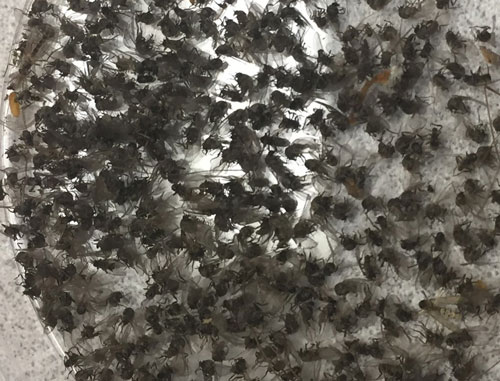
Buffalo gnat adults (Black fly). (Photo courtesy of Kelly Loftin.)
Black flies are very tiny, blood-sucking flies in the insect family Simuliidae. Contrary to their name, black flies may be gray, tan, or greenish. These small flies also have a distinctive hump behind their head; hence their common name, Buffalo gnats.
They breed in fast-moving water of streams and rivers. They are tremendous pests of
humans, domestic animals, and wildlife every spring, and are found in many areas of the United States including areas of Arkansas.
Outbreaks in Arkansas often occur following heavy rainfall and cooler temperatures, which is most commonly observed in the springtime. Several owners of small poultry flocks in Arkansas have lost either some or all, of their birds due to attacks from Buffalo gnats.
Buffalo gnats require moving water for their lifecycle. The females attach hundreds of eggs (150-800) to submerged objects such as plants, rocks, and leaves. The time frame for the eggs to hatch is dependent on the water temperature.
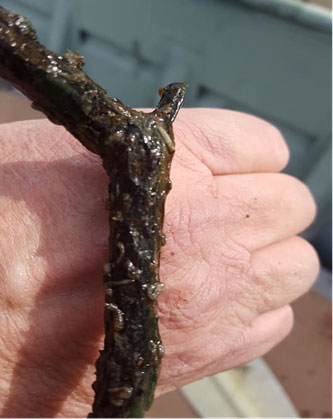
Buffalo gnat larvae visible on wooden branch from a stream. (Photo courtesy of Jennifer
Caraway)
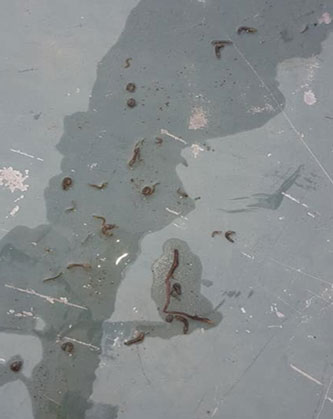
Buffalo gnat larvae. (Photo courtesy of Jennifer Caraway)
Eggs often hatch within 4-5 days at 70 degrees Fahrenheit. The larvae then attach themselves to the submerged objects and filter feed on bacteria and algae in the water. The development time of the larvae also depends on several factors such as water temperature and available food. These larvae mature and spin a cocoon to pupate in; from which, the adults emerge in the late spring.
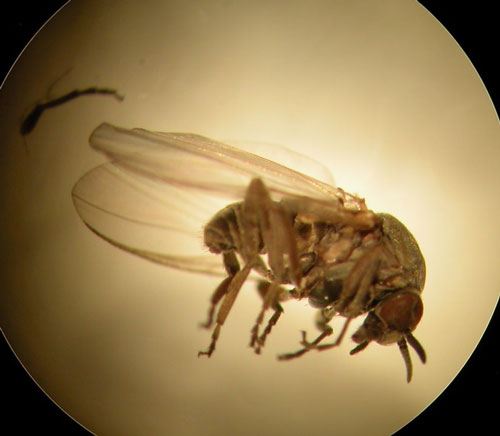
Buffalo gnat adult (Black fly). (Photo courtesy of Kelly Loftin.)
Adult males and female blackflies feed on nectar. However, females of most species also need blood to produce eggs. Therefore, the females immediately search for a blood meal and may travel more than ten miles to obtain one.
The entire life cycle takes about 4- 6 weeks depending on the species of black fly, temperature, available food, and water temperature. It is possible for several generations to be produced each year. Fortunately, the adults only live 2-3 weeks.
The bites of the buffalo gnat can be very painful and itchy and some people and animals may have an allergic reaction to the anticoagulant injected by the fly at the bite.
The adult females feed on the blood of many animals including:
- horses
- cattle
- sheep
- goats
- poultry
- humans
The bites are usually concentrated around the head on the ears, nose, and face. However, they will bite any exposed area.
In addition to blood loss, the flies can cause severe irritation to the animals causing them to continually seek areas to avoid being bitten. Buffalo gnats do have a preference of one host over another, hence their other common name being the Turkey Gnat.
Large concentrations of these gnats can cause death in animals and poultry due to blood loss, irritation, shock, and suffocation.
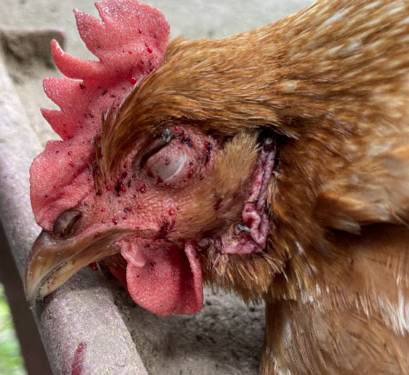
Poultry that has been bitten by buffalo gnats usually have small, scabbed cuts on the face and combs. There may also be blood-stained feathers on the head, neck, and wings.
Some birds may be found dead with no apparent lesions; however, a closer examination usually reveals the very small gnats in the feathers covering the ears or on the head.
The face and comb of the bird may also be swollen due to large numbers of bites.
Animals such as horses and cattle usually have small, scabbed-over cuts and generalized swelling of the ears. These cuts will usually ooze blood persistently.
How do I control buffalo gnats?
Buffalo gnats feed in the daytime, so the best method of protection is avoidance. Livestock and poultry should be sheltered in darker areas during the daytime to lessen the chance of being bitten.
The gnats also prefer to feed when there is little, if any, wind. Therefore, the use of fans to circulate air where the animals are kept may be helpful.
Insecticides containing permethrin compounds can be used for temporary reduction of buffalo gnat numbers; however, these products only kill the flies they contact and, as such, animal areas, yards, and barns need to be sprayed periodically.
A few poultry owners use Citronella oil-containing compounds on their birds with some success. Other methods of prevention used by poultry owners include hanging fly strips or shiny aluminum pie plates that have been coated with a light coating of oil in the sunlight. The black flies rest on the yellow fly strips or coated pie plates and become stuck.
It is important to check your poultry periodically, especially those that may be caged in areas where they are continuously exposed to sunlight. If you notice suspicious lesions, increased restlessness, a drop in egg production, small amounts of blood around the face, or unexplained deaths, you may have a problem with buffalo gnats.
How do I protect myself from buffalo gnat bites?
Since people can also be bitten by buffalo gnats, it is important to protect yourself. If you have to be outside when the gnats are active, wear long-sleeved, bright-colored clothing (do not wear light blue). Head and shoulder nets can also be worn. Insect repellants that contain DEET may also be helpful. Clothing can also be treated with fly repellents.
Individuals that get bitten and have an allergic reaction should seek prompt medical attention.
Fortunately, in Arkansas, the time for adult black fly activity is short and declines when temperatures rise above 80 degrees Fahrenheit.
For additional information on Buffalo gnats or for more information on poultry diseases, care, and husbandry, contact your local county extension agent, or the Extension Poultry Health Veterinarian (F. Dustan Clark, DVM, fdclark@uark.edu, 479-957-4245).
If you see something in your flock that is unusual or have bird losses get help immediately. Contact your local veterinarian, local county extension agent, Extension poultry veterinarian, state veterinarian, or USDA hotline (1-866-536-7593).